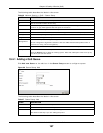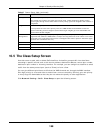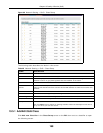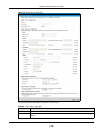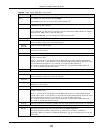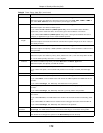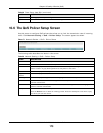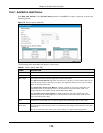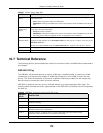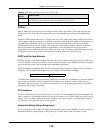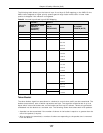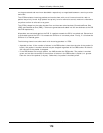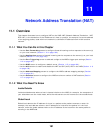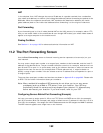
Chapter 10 Quality of Service (QoS)
VMG5313-B10A/-B30A Series User’s Guide
175
10.7 Technical Reference
The following section contains additional technical information about the VMG features described in
this chapter.
IEEE 802.1Q Tag
The IEEE 802.1Q standard defines an explicit VLAN tag in the MAC header to identify the VLAN
membership of a frame across bridges. A VLAN tag includes the 12-bit VLAN ID and 3-bit user
priority. The VLAN ID associates a frame with a specific VLAN and provides the information that
devices need to process the frame across the network.
IEEE 802.1p specifies the user priority field and defines up to eight separate traffic types. The
following table describes the traffic types defined in the IEEE 802.1d standard (which incorporates
the 802.1p).
Conforming
Action
Specify what the VMG does for packets within the committed rate and burst size (green-
marked packets).
• Pass: Send the packets without modification.
• DSCP Mark: Change the DSCP mark value of the packets. Enter the DSCP mark value to
use.
Non-
Conforming
Action
Specify what the VMG does for packets that exceed the excess burst size or peak rate and
burst size (red-marked packets).
• Drop: Discard the packets.
• DSCP Mark: Change the DSCP mark value of the packets. Enter the DSCP mark value to
use. The packets may be dropped if there is congestion on the network.
Available Class
Selected Class
Select a QoS classifier to apply this QoS policer to traffic that matches the QoS classifier.
Highlight a QoS classifier in the Available Class box and use the > button to move it to the
Selected Class box.
To remove a QoS classifier from the Selected Class box, select it and use the < button.
Apply Click Apply to save your changes.
Cancel Click Cancel to exit this screen without saving.
Table 51 Policer Setup: Add/Edit
LABEL DESCRIPTION
Table 52 IEEE 802.1p Priority Level and Traffic Type
PRIORITY
LEVEL
TRAFFIC TYPE
Level 7 Typically used for network control traffic such as router configuration messages.
Level 6 Typically used for voice traffic that is especially sensitive to jitter (jitter is the
variations in delay).
Level 5 Typically used for video that consumes high bandwidth and is sensitive to jitter.
Level 4 Typically used for controlled load, latency-sensitive traffic such as SNA (Systems
Network Architecture) transactions.
Level 3 Typically used for “excellent effort” or better than best effort and would include
important business traffic that can tolerate some delay.
Level 2 This is for “spare bandwidth”.



